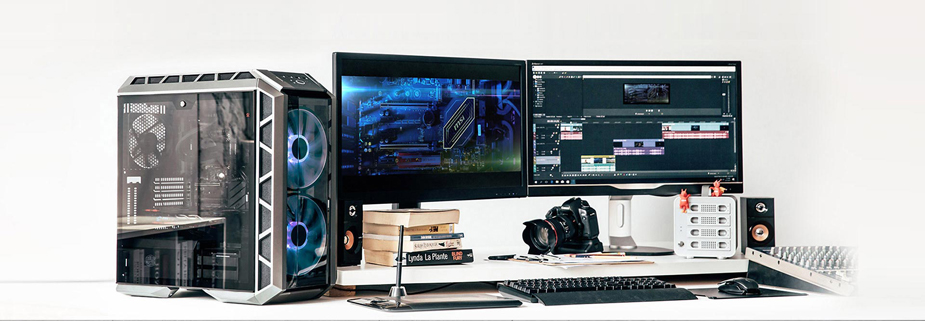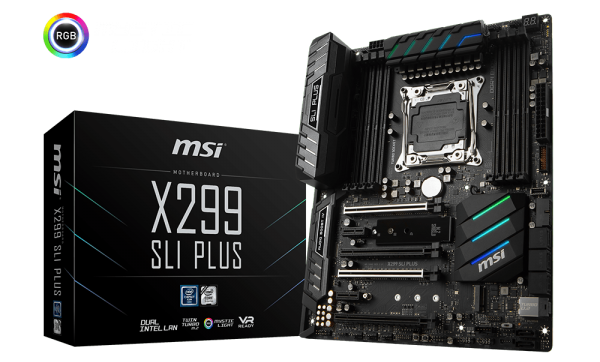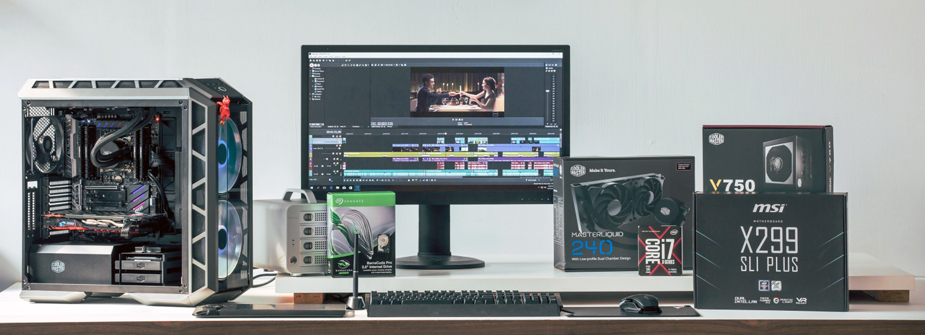How to Build a Desktop for Video Editing
{{blogList.blogTitle}}

Build a 4K High-performance Video Editing Computer
We believe that DIY enthusiasts certainly ensure the best use of money for assembling a computer that truly meets the needs. And nowadays, the most widely used purpose for computers is none other than gaming. And then, there is video editing, which has become ever popular. In previous articles, we have already talked about the building of gaming computers. This time around, we will introduce to you how to build video editing computers!
With the advance of science and technology, it is more and more common for people to become Youtubers or streamers. Video editing needs are becoming a required skill in this new era. From Hollywood filming blockbuster films to intro videos shown at wedding ceremonies, and even video clips filmed with cellphones reporting the acts of littering, various post-production and video editing processes are required. For example, the length of the video, adjustments to picture quality, the number of special effects, the utilization of color grading or filtering, etc. All of the abovementioned needs must be done on a fully functional PC. This perfectly illustrates the saying, "A workman must first sharpen his tools if he is to do his work well."
And with so many different computer specifications, what characteristics must be considered when building such high-performance computers? Video editing work is very demanding of the computer's performance, and CPU, GPU, memory and hard disk are the four key parts that have the most impact on performance. As for the motherboard, it is the communication center at the four major hardware parts. Therefore, the key to the smooth video editing work depends on whether the motherboard is able to fully support or let these four parts work together in a stable condition. In the following, we will show you how to pick a suitable motherboard when these four parts are taken into consideration.
Four Key Points to Consider When Building a 4K High-performance Video Editing Computer
When picking a motherboard dedicated for 4K editing computers, in addition to considering the stability and rich scalability of the motherboard, there are some key points that are different from typical gaming PCs, which may be overlooked by some people. We hereby provide the explanation for you:
⇒ Key point 1: The processor core is very important. All the editing and file conversion work depends on it

When it comes to shopping for 4K video editing computer, the CPU is still one of the most important parts. Since most of the video editing software nowadays support multi-core computing, and multi-core processors can significantly improve the processing performance for video decoding, previewing, and the synchronized conversion for multiple videos, we recommend processors with six or more cores for computers that are used for general 4K video editing tasks.
As for the Intel platform, current-gen processors have as many as 18 cores; we believe that this will meet the needs of audiovisual enthusiasts who require ultimate performance. Of course, as the saying goes, "a good horse must also be fitted with a good saddle", we recommend the MSI X299 SLI PLUS to complement these processors. This motherboard boasts a very luxurious power supply design, and is equipped with MSI's exclusive military-grade materials and digital power supply technology; therefore, it is able to support the newest Intel X series 18-core processors - Even in an environment with the synchronized conversion of multiple videos, this motherboard will still ensure system stability, fulfilling the editing users' needs for prolonged periods of stable operation.
⇒ Key point 2: The memory plays an important role; we depend on it when simultaneously editing multiple streaming videos
When it comes to video editing, in addition to the processor, memory also plays an important role; it is especially demanding on memory resources when editing multiple streaming videos, or exporting videos. Try to recall whether it is often for the "insufficient memory" messages to appear when you were editing a video or saving a file. This is because when you edit multiple video streams, the number and speed of memory will impact the time spent on processing, rendering and previewing videos. Therefore, we can see the importance of memory in video editing. Usually, when handling 4K videos, we recommend choosing 16GB or larger capacity for regular video editing tasks. Professional film editors require memory of at least 32GB or larger capacity.
It could be said that this is closely linked to the design of the motherboard. Currently, typical motherboards are mostly designed with two to four memory slots, supporting up to 64GB of memory. However, for professional level 4K audiovisual enthusiasts, this is far from sufficient. Therefore, we also recommend X299 SLI PLUS to those who belong to this market; it supports up to 8 sets of memory, and up to 128GB of ultra-large capacity, and will let you handle multiple video streaming editing tasks with ease.
Furthermore, all MSI X299/Z370 motherboards support the DDR4 BOOST technology specifically designed for memory optimization. Through optimized circuit design and completely isolated transmission area, it yields the purest signals for data transmission between the memory and processor, taking performance and stability to a whole new level. Therefore, you will never have to worry about the system crashing while editing videos.
⇒ Key point 3: A complete high-speed storage interface can effectively reduce file transfer time
Since 4K video recording equipment has become increasingly popular, many audiovisual workers are getting started with 4K video post-production editing. However, with 4K quality videos, in addition to requiring a larger storage space, it is also often required to access large amount of data during the editing process. Therefore, its demand for high-speed storage devices will be much more than other applications, in order to handle real-time editing and special effects simultaneously.
All of MSI's SLI PLUS series motherboards designed for audiovisual editing have adopted the industry's latest AsMedia 3142 control chip, which supports a higher transfer bandwidth. Therefore, not only does it provide excellent performance for transferring on a single USB 3.1 Gen 2 device, even when you use two USB 3.1 Gen 2s simultaneously to transfer videos, you will still enjoy great transferring results, without experiencing slowdown issues at all.
In addition, in order to enjoy higher video loading speeds, more and more video editing PCs are adopting the M.2 SSD to replace the traditional mechanical hard drive. With the aid of Gen3x4 bandwidth, SSDs with M.2 interface can provide transferring performance of up to 32Gb/s, which is a significant improvement over the 6Gb/s of the traditional hard drives. However, as the transferring speeds of M.2 increases greatly, it also leads to its operating temperature staying at a high level.
This will not only impact the life of these SSDs , but also affect the transferring performance of M.2. Therefore, motherboard manufacturers will have to solve the cooling issues for M.2.
The X299 SLI PLUS motherboard is especially equipped with MSI's exclusive M.2 Shield cooling solution. With an unibody aluminum heat sink and thermal silicone, the heat generated from the operation of M.2 SSD can be dissipated through the heat sink, which effectively prevents the slowdown of M.2 SSD caused by overheating, and avoids electromagnetic wave (EMI) interference, providing the cleanest signals and stability to M.2 SSD.
Apart from supporting two sets of M.2, X299 SLI PLUS provides a set of U.2 interface found only on enterprise-level storage devices. If you need higher stability and transferring performance, you can purchase storage products that have adopted this interface. Being equipped with both the M.2 and U.2 next generation transfer interface, proves that X299 SLI PLUS is a motherboard that is specifically designed for 4K audiovisual PCs.
⇒ Key point 4: High-end graphics cards are indispensable; the enhancement of graphics card slots is especially important
Video editors know that if there's a lackluster hardware performance, not only will video playback be choppy, if post-production effects are to be added, the rendering time will be increased even more. And the biggest factor which impacts rendering speed the most is the graphics card. MSI's X299 SLI PLUS motherboard not only supports regular gaming graphics cards, but is also completely compatible with NVIDIA QUADRO, which are graphics cards dedicated to computer-aided design.
Moreover, in order to meet the needs of professional audiovisual editing users, X299 SLI PLUS even supports QUADRO SLI technology, providing you with the best rendering processing performance.
With improved performance comes cooling issues. Therefore, high-end video cards or graphics cards will typically be equipped with multiple cooling fans and large heat sinks, increasing their overall weight. This is a heavy burden for the PCI-Ex16 slots, so it is often heard that slots were pulled up from the bottom due to the graphics cards being overweight.
To prevent this issue from happening, all MSI motherboards are equipped with at least one PCI-E Steel Armor. In addition to wrapping armor around slots, we have also reinforced the slots through adding multiple solder joints on the back of the product, in order to prevent overweight graphics cards from causing damage to the PCI-Ex16 slots, which is indeed a very thoughtful design.
For professional film editors -- Recommended professional level video editing motherboards

The X299 SLI PLUS has adopted an all-black PCB design and supports SLI technology. Moreover, it is very rich and complete in terms of specifications; in addition to the four key points mentioned earlier, it is also equipped with dual Intel LAN ports, providing high-speed online editing and high-speed sharing, making it a product specifically designed for video editors.
For Youtubers and regular editing enthusiasts -- Recommended entry-level 4K video editing motherboards

For motherboard products available in the market today, Z370 SLI PLUS offers one of the best price-performance ratios. It has adopted a black PCB in its overall design, comes with a thick heat sink armor, and is able to keep the system stable even under long hours of operation. Moreover, it also has a very high scalability, and is equipped with two sets of Turbo M.2, Lightning USB 3.1 Gen2, and 6 sets of SATA 3.0, which will meet the needs of mainstream Youtuber and regular editing enthusiasts.
Other recommended equipment

•Motherboard and processor: X299 SLI PLUS with Intel i9-7900X (10-core/20-thread processor), Z370 SLI PLUS with i7-8700K (6-core/12-thread processor)
•Memory: HyperX PREDATOR 3000 MHz (32GB)
•Graphics card: GTX 1080 GAMING X 8G
•Solid-state drive (SSD): Intel SSD 600P (256G Boot Drive)
•Hard drive (HDD): Seagate BarraCuda PRO 3.5" HDD 10 TB
•Water cooling: Cooler Master MASTERLIQUID 240
•Case: Cooler Master H500P
•Power supply: Cooler Master V750
Check out the 4K Video Editing PC Build video
How to Build a Desktop for Video Editing
Source: https://id.msi.com/blog/4K-Video-Editing-Computer-Building-Guide
0 Response to "How to Build a Desktop for Video Editing"
Post a Comment